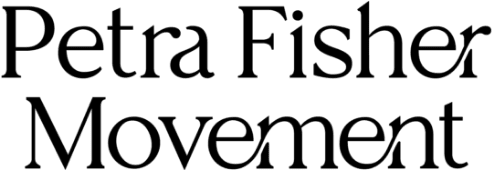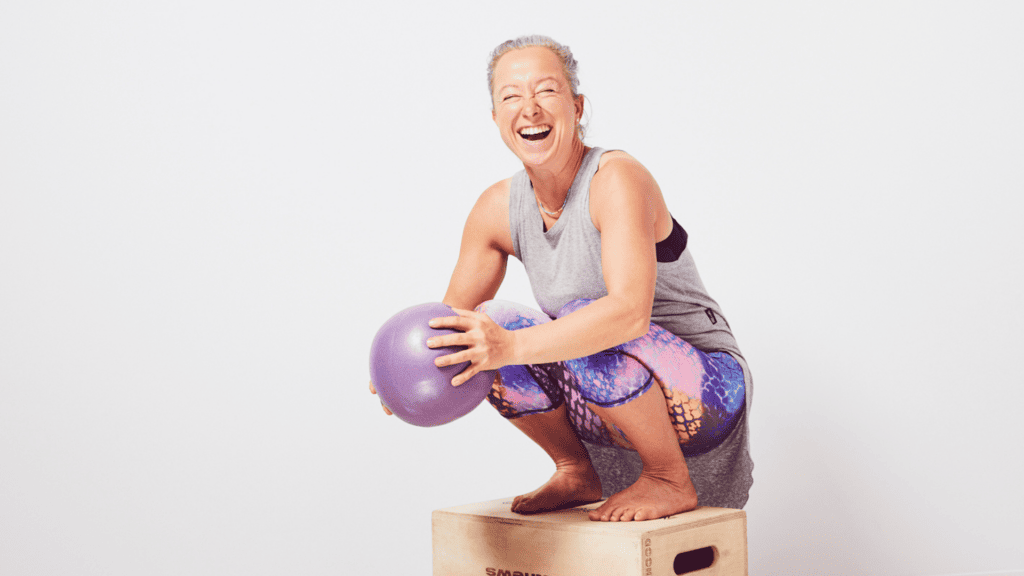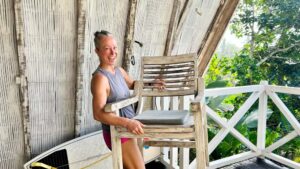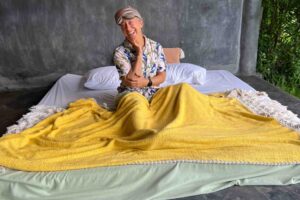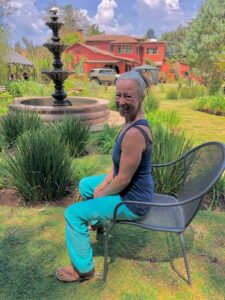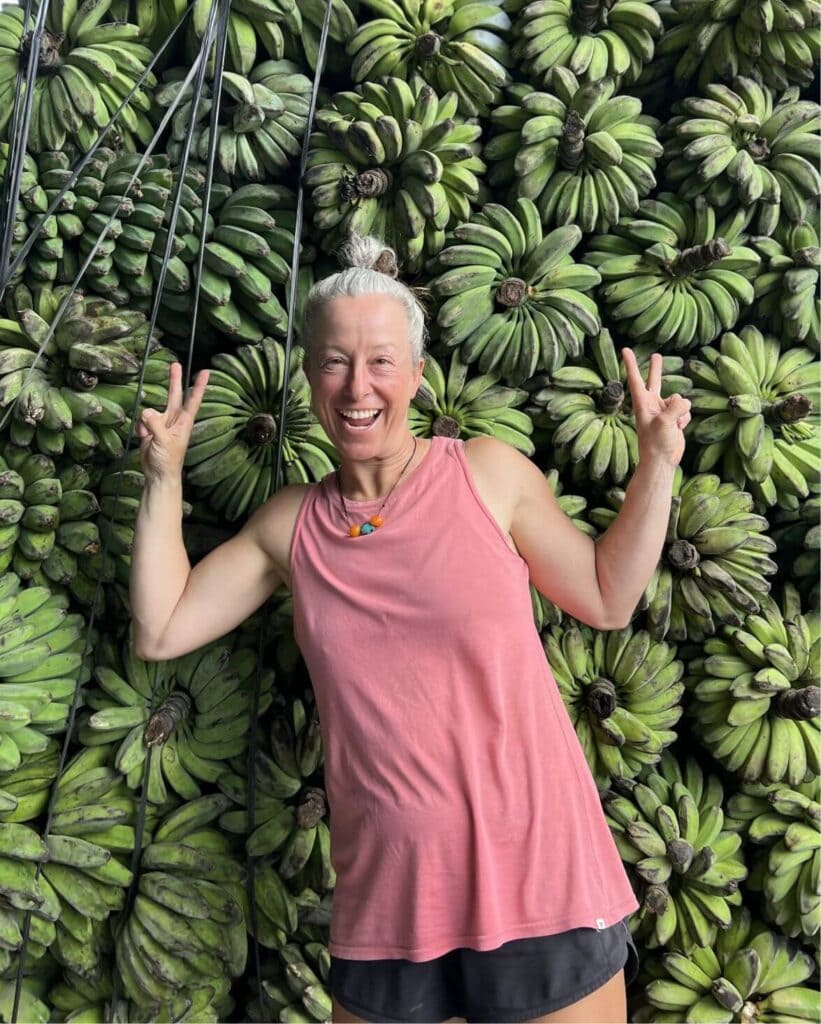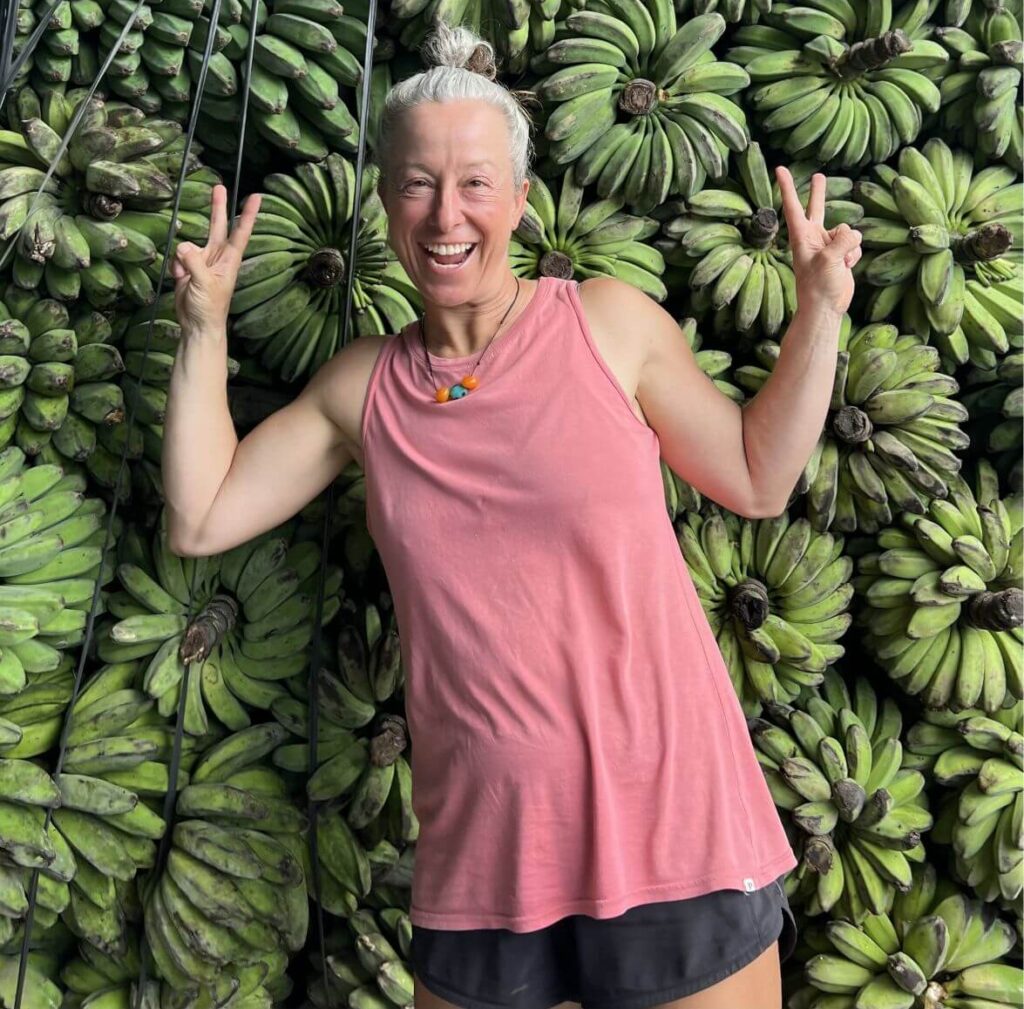UPDATED: April 16, 2025
I get a lot of questions about what movement equipment I recommend.
Carefully chosen movement props can be real game changers!
Good props can help you do a much wider variety of exercises (which means more varied options for your body), meet your body ‘where it’s at’ so you make faster progress, and build your body awareness and skills.
But it’s also easy to buy stuff that ends up unused in your basement closet.
This means I personally love items that are versatile and deliver a lot of bang for your buck so you can actually use them!
So today I thought I’d share a list of my favourite movement tools and brands! Plus some ways you can get started using them!
I’ve split the list into the basics that I use All The Time, and some more specialized items that are super useful but may not be right for you (yet). And then I added a few of my favourite ‘luxury’ purchases in case you want to treat yourself!
Whether you’re a beginner just starting your movement journey or an experienced practitioner looking to take your mobility practice to the next level – I want to help you build your (literal) movement toolbox! Let’s dive in! A quick note – it’s important to me to stay unbiased in my recommendations. 99% of everything on my list I’ve bought myself (with a few exceptions for brands that have been recommended by my Move Better, Live Better Facebook community members) and I never have affiliate codes to share.
Weekly movement inspiration you can’t wait to read!
Why You Should Use Props
Movement gear will enhance your movement & joint mobility practice. Movement props can:
👉 allow you do exercises that are basically impossible without props, like rolling your feet out or learning to hang
👉 help you customize exercises and positions so they work better for your body with fewer compensations and more targeted results
👉 increase challenge & intensity (building strength & helping your body to adapt and grow)
👉boost your body awareness and erase your body ‘blindspots’ by giving you immediate tactile feedback
👉give you a helping hand so you can climb the movement learning curve faster and with less frustration
To sum it up – having the right tools gives you more options for exercises and helps you get better results, faster. And thankfully, getting started doesn’t have to be complicated (or cost a ton of $$$!).
Now, let’s dive into the wonderful world of props!
#1 Essential Basics
The gear in this section includes versatile items that I use all the time, for many types of exercise and even in my daily life movement.
These are the items that I can’t live without and take with me everywhere I go. If you’re just getting started, these are the items I recommend that you purchase first.
12” Half Round Foam Rollers
Uses: I use these every day for sooooo many purposes – both exercises and in my daily life. They’re a great tool for stretching AND a good tool to provide support for your body, and I use them in all of my teaching.
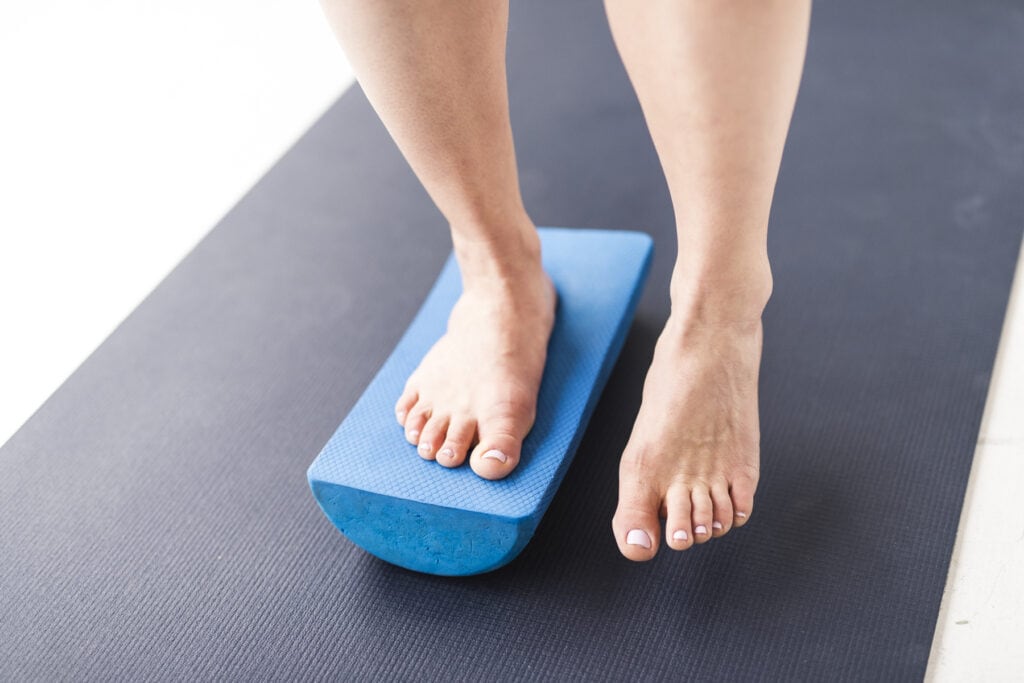
For example, half rollers are great for stretching your calves and hamstrings (really important for most people who are transitioning to minimalist footwear). (For instance, give this yummy double calf stretch a try!)
They’re also very useful for sitting on. Because of the rocker, sitting on a half roller can help you improve how you load your hips, core & pelvic floor during daily life and during seated exercises. Here’s how I use mine with the round side down on a chair to help tilt my pelvis and keep it in a neutral position when I’m seated (this optmizes core & pelvic floor function and my low back loves it too).
They also work well as a cushion for my knees when lunging. And as a pillow for my head if I’m lying down. And as a surface for stretching my toes on. Honestly, I could go on and on.
Best for: Everyone
Where to buy: My faves are from Yogaaccessories.com. They are more durable and feel better on the skin than the white ones – but they don’t work for people with latex allergies. They are no longer selling the 12″ ones but you can get the 36″ and easily cut it down to create several half rollers. If they’re out of stock, you can find lots of other half rollers but typically the foam isn’t the same density, like these ones from ProSource Fit. Both of these places have a mailing list. Sign up to get 10% off your order.
If you’re in Canada you can get the same ones at Cool East Market.
For those in Australia, you can purchase them from 66Fit or Hart Sport.
If you’re in the UK, you can get them from The Physical Company or 66Fit.
In Europe, they’re available from Body Solid.
If you’re in Canada you can get the same ones at Cool East Market.
If you’re in the UK, you can get them from The Physical Company.
In Europe, they’re available from Body Solid.
Pro tip: Avoid the very hard high density/black foam rollers – they’re too intense. And if you can’t find one, just get a regular foam roller & cut it in half with a bread knife!
A Yoga Mat
Uses: I practically live on my yoga mat and use mine for both exercise and for sitting on the floor for work or life. It’s just no fun to try to exercise or sit on the floor if it’s dusty or slippery – having a good mat around is an easy way to create an inviting space for your movement practice.
Best for: Everyone
Where to buy: Any mat will do but I really appreciate the stickiness, durability and density of the high end Manduka Pro version. Jade and B Yoga are two other high-quality, more eco-friendly alternatives. My Manduka Pro mats have lasted through 7+ years of hard use and look almost as good as new!
Pro tip: Avoid very cheap mats. They can give off a nasty chemical smell, get slippery and don’t last very long.
Yoga Blocks
Uses: I use yoga blocks daily when I’m practicing the CARs (Controlled Articular Rotations) joint mobility routine that I teach in my Joints for Life program. Holding a yoga block during CARs helps to create tension and effort in your body, which helps add more awareness and physical impact to the CARs.
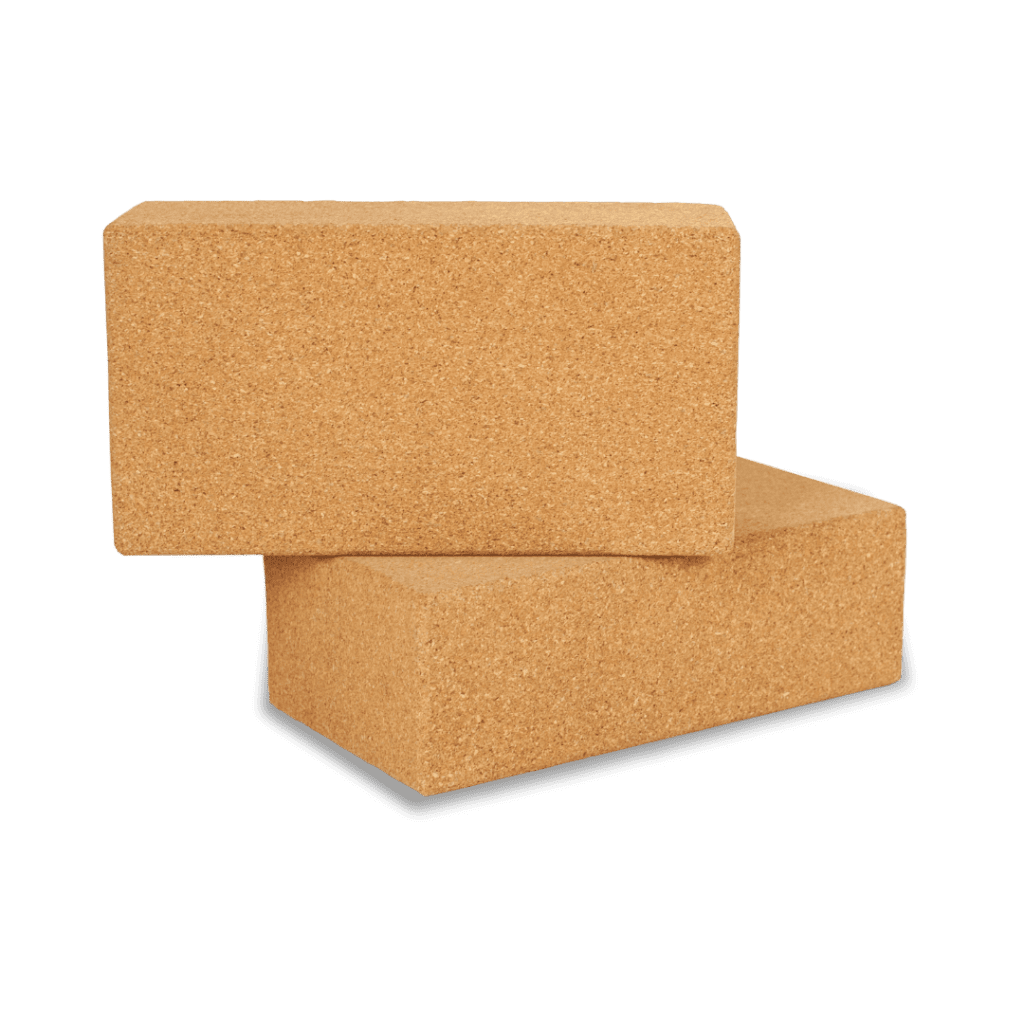
Yoga blocks are also great for practicing balance (see if you can do this one-legged exercise) & foot work or as a head for side-lying exercises. Expensive ones tend to be firmer, which I prefer, but any will work fine. Cork ones are nice too.
Best for: Everyone
Where to buy: Manduka and Hugger Mugger are two pricier, but high quality options. Gaiam are a less expensive option but they are thinner.
Pro tip: There are many other options available. Avoid the very soft foam blocks (they aren’t supportive or durable) and opt for a thicker, denser block that is best for all around use.
Yoga Strap
Uses: Yoga straps are another multi-purpose tool that I use for mobility work, stretching and even as an anchor for side hanging exercises.
Straps are a bit like an ‘arm-extender’ arm so they’re super helpful when you’re working on areas that are tighter, less flexible or hard to reach. (One example is this standing quad stretch. Most people can’t do this stretch without creating some sort of body compensation – unless they have a strap!). You’ll also find yourself using a strap for many hamstring & shoulder exercises.
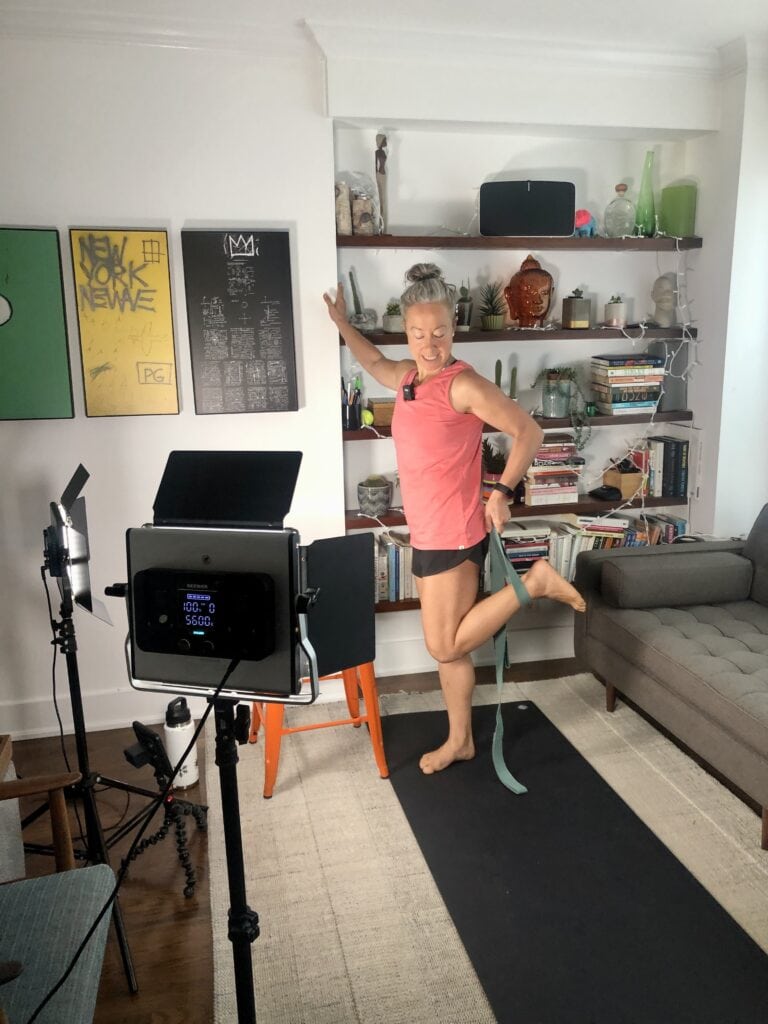
Best for: Everyone
Where to buy: I like the ones from Hugger Mugger or Manduka.
Pro tip: I prefer longer straps – look for one that’s 8’-10’ with loops or a buckle clip for best results. If you’re not ready to invest, you can easily substitute a scarf or a belt that you already own.
Yoga Tune Up Balls or Similar
Uses: Balls are a wonderful way to give yourself a self massage. Not only does it feel great, but it can help you connect to your body and help relax your ‘tight’ bits.
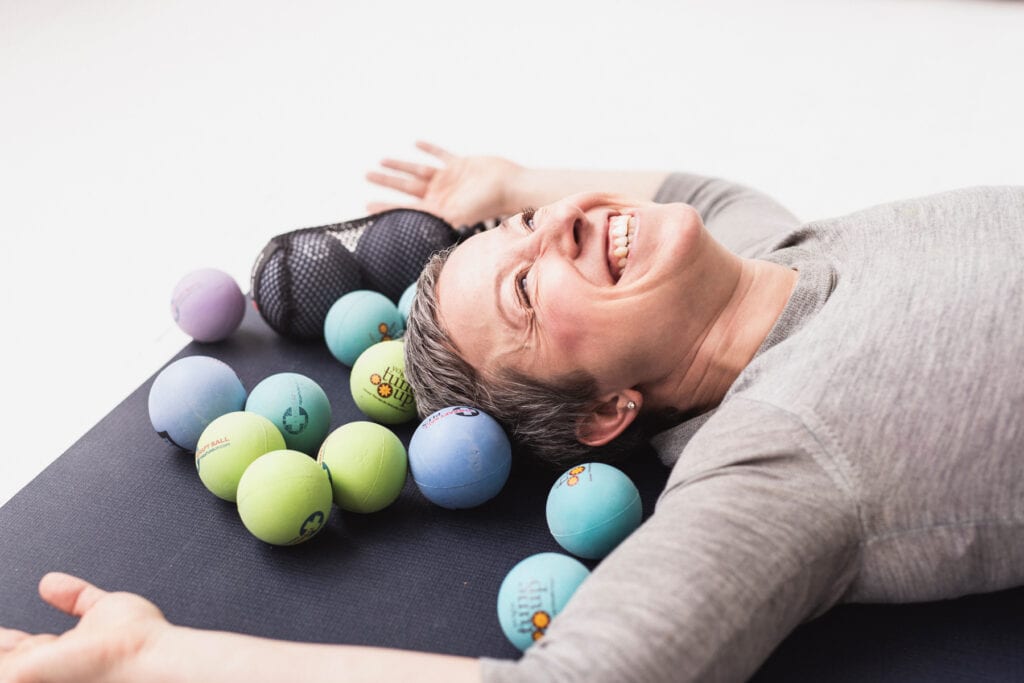
In particular, I think rolling your feet out is a really helpful and powerful foot exercise – in fact, it’s so good I put it into my free Free Your Feet program. Grab it right here and start rolling!
But don’t stop with your feet! You can do self massage with balls anywhere on your body especially at the beginning of a movement session to help you connect with your blind spots and improve your movement quality. Or just roll out some tension! Here’s one of my personal favourite roll outs for your neck & shoulders:
Best for: Everyone
Where to buy: Tune Up Fitness (the original size is the best multi-use option for most people to start with)
Pro tip: Not ready to invest? You can use a tennis ball, a pinky ball, or similar squishy ball. But please, please please skip the lacrosse balls, they’re too hard! If you’re new to rolling, Jill Miller’s book, The Roll Model Method is a great resource for learning proper technique. (Jill is the creator of Yoga Tune Up and a pioneer in the worlds of fitness, yoga, massage and pain-management).
Toe Spacers
Uses: Toe spacers (also called toe spreaders) are little devices designed to create a bit more space between your toes. This gives you better circulation, takes pressure off your nerves, and helps your feet function better.
Since modern shoes squish your toes and many of us have spent a lot of time wearing shoes, I think most people can benefit from using toe spacers, especially at the start of their barefoot journey.
But it’s important to remember that although toe spacers are a great tool, they aren’t the whole story on restoring foot function. For better changes, pair them with regular footwork and don’t plan to use them forever. (My free Free Your Feet program includes lots of exercises to help you create healthy, strong, resilient feet.)
Best for: Everyone, especially anyone with bunions, plantar fasciitis, flat feet, hammertoes or a neuroma
Where to buy: Correct Toes are my favourites because you can wear them in your shoes which helps you create more change, faster.
Pro tip: For more detailed recommendations, check out this post, “Everything You Need To Know About Toe Spacers.”
Weekly movement inspiration you can’t wait to read!
#2 Specialized Items To Expand Your Toolkit
Yoga Bolster
Uses: Bolsters provide a soft, supportive surface that can help you ease into positions until they’re more comfortable. This means you can use them both for exercises and to help you get good at one of my favourite lifestyle options, sitting on the floor!
Bolsters are super versatile and will really help you work with your hip flexors, pelvis and shoulders with fewer compensations and more comfort. Plus bolsters are wayyyy better than cushions or blankets for setting up one of my all time favourite exercises – the psoas release.
Best for: Everyone
Where to buy: Hugger Mugger or Manduka
Pro tip: Try to avoid really soft, squishy bolsters as they don’t provide much support. You may end up wanting to have a few different shapes & sizes of bolster to give yourself more options.
Adjustable Ankle Weights
Uses: Small weights are great for adding loads to joint mobility work and many shoulder exercises. Our bodies adapt to what we do frequently, so it’s a good idea to increase the intensity of your exercise on a regular basis. This helps you build strength & resilience.
I’d recommend you invest in weights once you’ve done Controlled Articular Rotations (CARs) from my Joints for Life program for 6-12 months. (Read more about why I love CARs so much right here).
You can also use ankle weights for other mobility focused exercises, such as the killer thigh workout in this post.
Best for: Someone who’s been doing daily CARs for 6+ months & wants to intensify & get stronger, or who wants to expand into additional mobility focused exercise.
Where to buy: AllPro
Pro tip: Ideally get adjustable weights that you can change from 1-5 lbs – this should be plenty when used for mobility focused exercises.
Gym Rings
Uses: Hanging is really, really good for you. Our upper body strength, our breathing capacity, our core and our shoulders all benefit from hanging & swinging – regularly! In fact, I consider hanging to be one of the major movement ‘macronutrients’ – like fat, carbs or protein, but the movement version.
Unfortunately, it’s tough to have a good hanging practice without investing in some equipment. Although there are some other options, you’ll get way more out of your hanging if you have something sturdy and overhead to hang from. Rings are inexpensive, adjustable and portable, which is why I travel with them and recommend them as my favourite hanging gear.
Best for: Anyone who wants to hang more (even if you’re just starting out)
Where to buy: Decathlon, ProSource Fit, or RepFitness
Pro tip: Interested in hanging but not sure how to get started? Click here to learn how!
Yoga Tune Up Coregeous Ball
Uses: I love using this soft squishy ball to give myself a really nice self massage.
Use it to roll out your core, which can help release tension in the belly and stimulate your vagus nerve (this helps you relax by activating your ‘rest & digest’ nervous system). A squishy ball is also a great tool for improving your breathing mechanics and releasing stress or tension in areas like the neck & chest. (Find even more ways to use your Coregeous Ball in my Pelvic Floor+ program!)
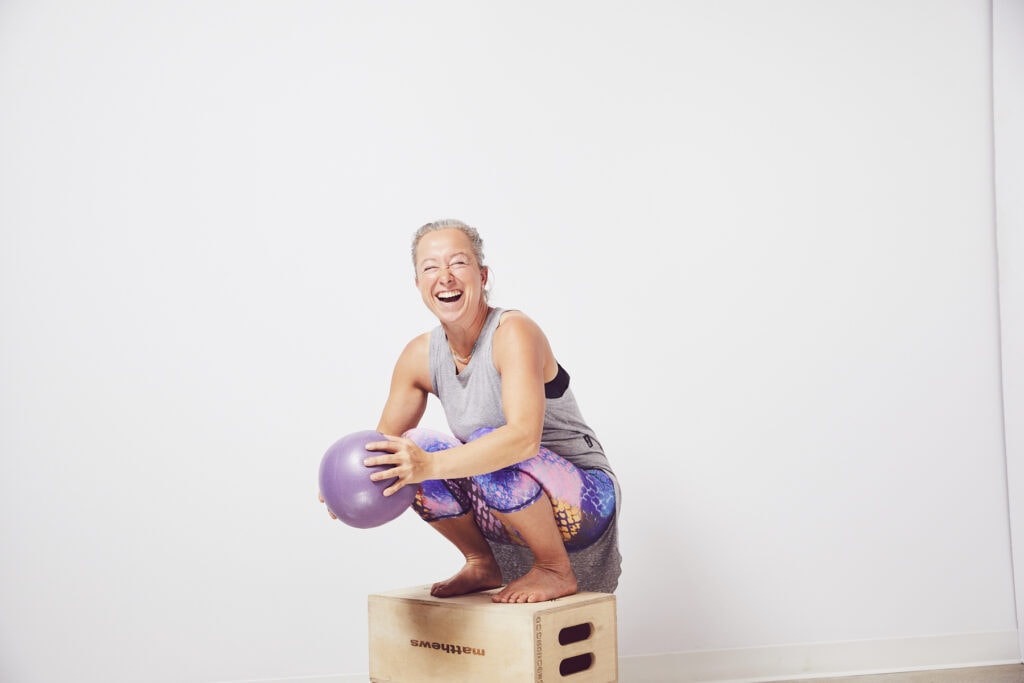
Best for: Everyone, especially those who have low back, pelvic floor or digestive issues or just love doing self-massage
Where to buy: Tune Up Fitness
Pro tip: Any 10-12 inch inflatable Pilates ball will work as a substitute but DO NOT use a hard ball like a soccer ball. If you’re new to rolling, Jill Miller’s book, The Roll Model Method is a great resource for learning proper technique. (Jill is the creator of Yoga Tune Up and a pioneer in the worlds of fitness, yoga, massage and pain-management).
Pull Up Assist Bands
Uses: I love using pull up assist bands to improve my spinal mobility work, especially the Segmented Cat/Cow exercise I teach in my Joints for Life program.
Ideally we want our entire spine to move like a zipper, but most of us have some spots that move too much and others that get really stuck. Using a band helps your brain reconnect to those sticky spots by providing some tactile feedback. A supple spine has lots of benefits (better breathing and happy core & pelvic floor muscles) and adding a band into your spinal work can be a total game-changer!
Best for: Anyone focused on building spinal mobility or wanting to add resistance to exercises.
Where to buy: Rogue Fitness or Westside Barbell
Pro tip: I recommend working with one of the very low resistance bands for feedback – a heavier band is too much.
#3 Treat Yourself
This is the fun section! You don’t need any of these to get great movement results, but you’ll probably enjoy having them!
TriggerPoint Therapy Foam Roller
Uses: Although you can use this to roll many parts of your body, I find it’s most useful for working on spinal mobility – especially to help extend and mobilize your upper back. Most of us spend lots of time hunched over our computers and phones – and doing a bit of regular spinal extension work like this is a good way to uncrunch yourself (which also supports better breathing, core strength & pelvic floor health BTW)
Here’s how I use this roller to mobilize my upper spine – basically every night before bed.
This roller is also generally good for self-massage to bring awareness and blood flow into other areas of the body like your calves & thighs. It’s lightweight, hollow and small so it’s another good tool to bring with you while traveling.
Best for: Anyone looking to focus on spinal mobility work
Where to buy: TriggerPoint
Pro tip: I love my roller – but guess what? A half-round foam roller like the first item in this post is really great for working on your spinal mobility too!
MELT Hand And Foot Kit
Uses: This is pure luxury! But if you want a treat, it’s awesome. The kit contains 2 sizes of small firm balls and one size of squishy ball plus a really good rubber band. I’ve had my MELT kit for 9 years and still use it all the time – the super squishy ball is my absolute favourite.
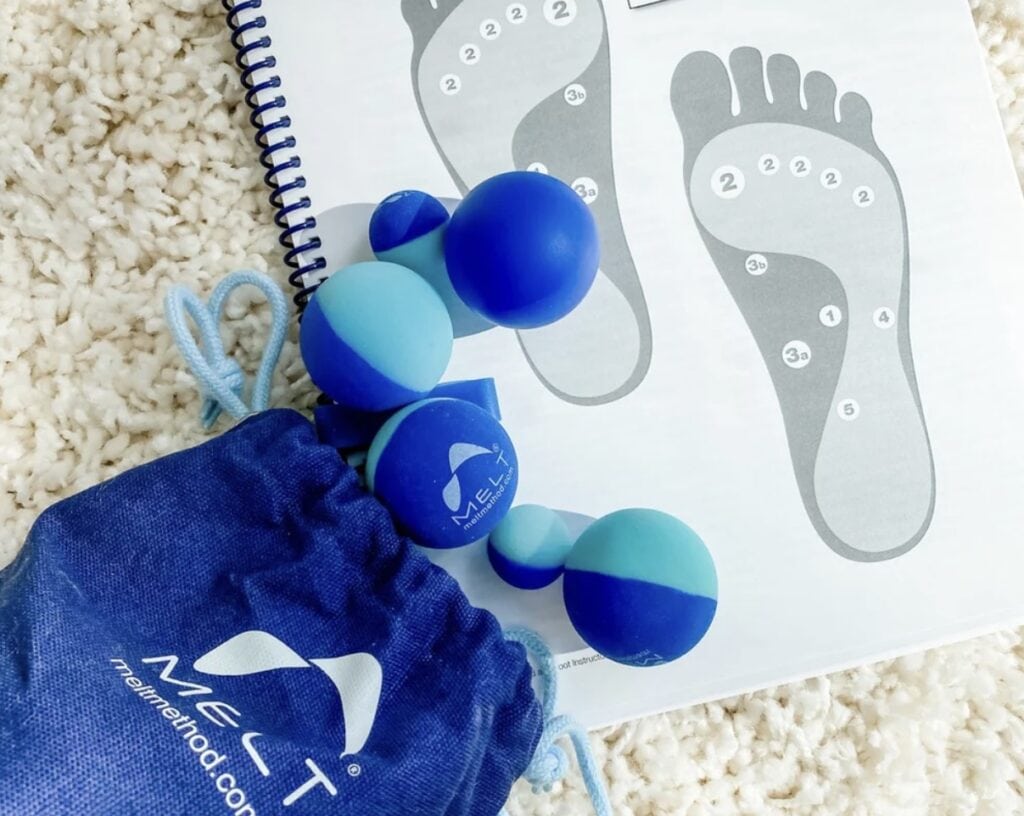
In addition to the exercise program that comes with the kit, you can use the balls for any foot rolling exercise and some toe mobility work too. You’ll find the different ball sizes help you get into different tissues than a larger ball and the band is really helpful if you have bunions.
Plus the balls in this kit can also be used for your hands and even for a nice facial massage.
Best for: Foot nerds!
Where to buy: Melt Method
Pro tip: You can also use small rubber balls (like pet toys) and a thick rubber brand (like a broccoli band) as substitutes. For some ideas of how to use these balls, sign up for my free Free Your Feet program.
Mobility Stick/Dowel
Uses: If you want to focus on improving your joint mobility, a pair of sticks or dowels are really useful. They’re a great tool that can help you balance and create more tension to make your mobility work more effective and creative. They can allow you to get better leverage for upper body exercises such as this elbow mobility exercise from my Take10 program.
Best for: Anyone who wants to focus on a Kinstretch style joint mobility practice (I teach a lot of this in the joint mobility section of my Take10 program)
Where to buy: Stick Mobility
Pro tip: You can also go to the hardware store and pick up a couple of 6’x1” dowels with rubber furniture tips – that’s what I did! Broom handles work fine too, but don’t use anything flimsy like a Swiffer.
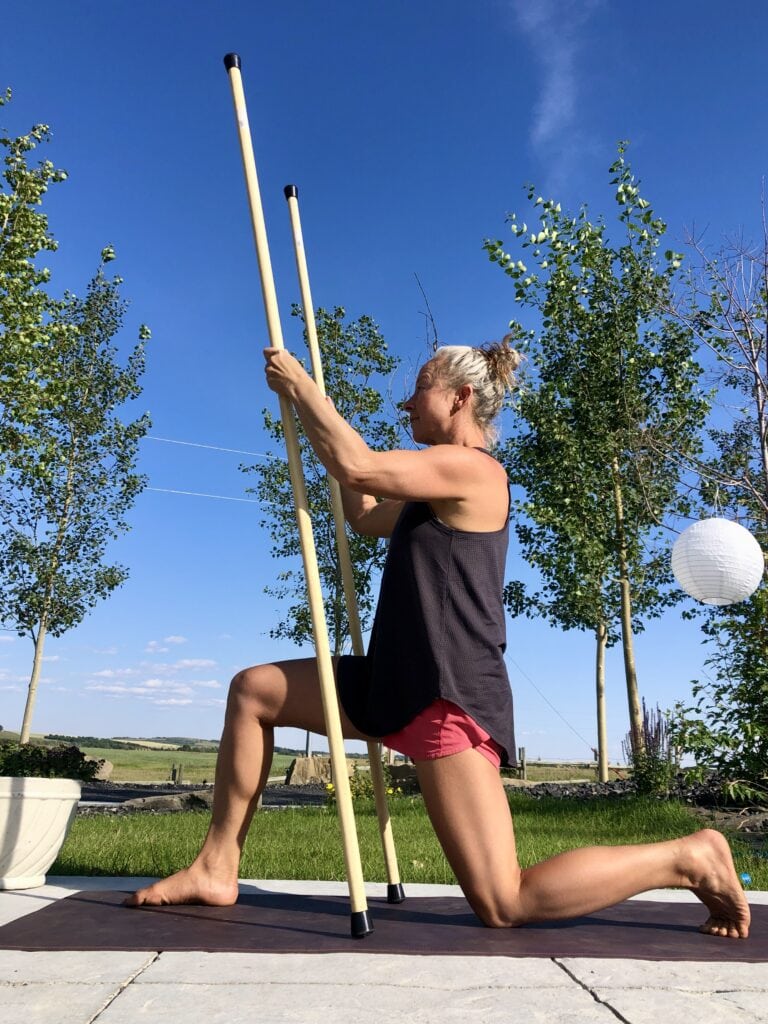
Balance Beam
Uses: Good balance is an absolute necessity for healthy movement! You can get a long way just by practicing standing on one leg. However, a balance beam is a great way to increase the challenge, build more skill, and even improve your foot & hip strength. Simply learning to walk forward, backwards & side shuffling on your beam can have a huge impact and is also a ton of fun – and that’s just the beginning!
Best for: Anyone looking to improve their balance or foot strength.
Where to buy: TFC Balance Beam or TFC SoleMate
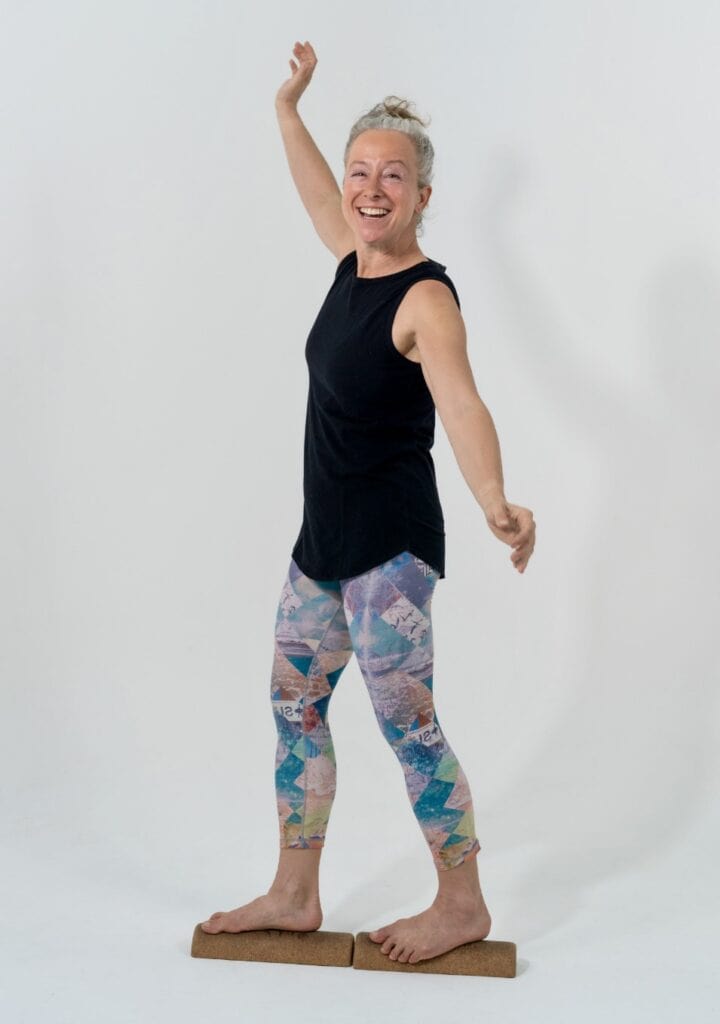
(*full disclosure TFC gave me the SoleMate as a gift because they know I travel a lot – and I’ve had my ‘no free stuff’ policy in place ever since. It really is nice though especially if you don’t want a full length beam).
Pro tip: A 2×4 also works well for most people or even tape on the floor can be a good substitute. Want to get started right now? Learn five ways to improve your balance right here.
AiM Wedges
Uses: These wedges are incredibly helpful in restoring foot function – they’re perfect for bolstering up the parts of your feet that aren’t moving well (yet). This helps your feet learn to move better, especially for the essential patterns of pronation & supination that most of us are missing. I use mine every day and they’ve been game changers for me – BUT they’re a bit technical and take some time to figure out. I’ll be teaching with them more over the coming year as I study more with Gary Ward, their creator.
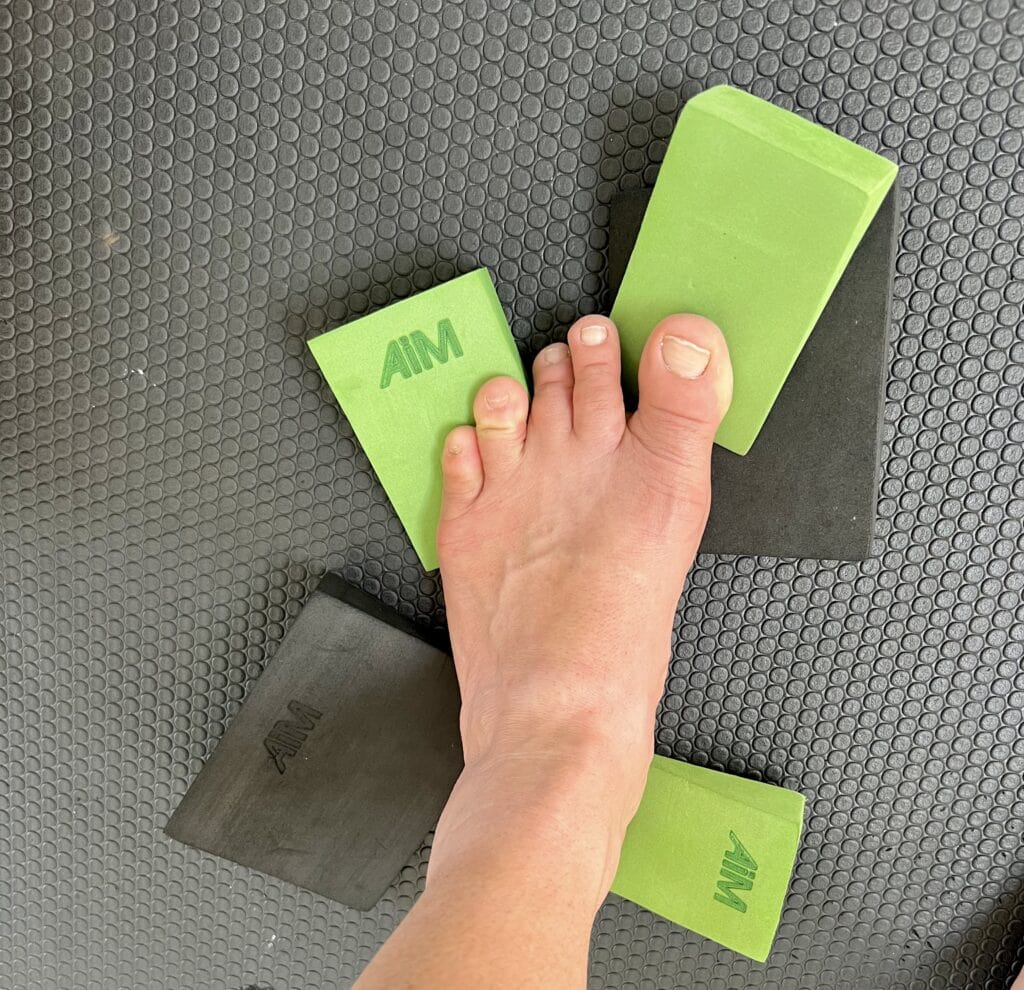
Best for: Someone who’s working on feet as a priority and who’s willing to commit to learning how to use them.
Where to buy: Finding Centre – they’re only sold as a package with the Wake Your Feet Up course created by Gary Ward because that will help you learn to use them.
Pro tip: Get ready for a learning curve! It took me about 4 years to start using the wedges but now that I understand them better I think they’re amazing.
Bonus Section – Stuff You Already Own!
Don’t feel like buying anything new? Here’s a quick list of stuff that’s probably lying around your house that’s great for movement work.
Try some of these to enhance your movement practice:
1) A full length mirror – movement work is about self-observation which means a mirror can help you make a lot of progress.
2) A flat seated chair or bench – so useful for practicing pelvis & hip mobility and a great prop if you have sore knees that make it hard for you to kneel or set up on hands & knees.
3) Cushions & blankets – good for padding and for bolstering your body – one of the keys to ‘meeting your body where you’re at’! Try watching my Ribcage Magic videos then using cushions & blankets to bolster your upper body for all your lying-down exercises.
4) Paper plates – great for sliding exercises on carpet (furniture sliders are great for this too)
5) Soup cans – No ankle weights? No problem – just grab a couple of cans from your kitchen when you need to add a little weight
6) A pair of nylons, a belt or a tie – when you’re in need of a strap but don’t own one
These are just some of the common household items you can use for movement work but the possibilities are endless – be creative!!
If you have any questions, or if the links I shared don’t work for your region, head to my Move Better Live Better community on Facebook and ask the folks in there for their best sources.
Now get your gear and get moving! And don’t forget to sign up for my weekly newsletter for more tips & advice on how to use your new props in your movement practice.
